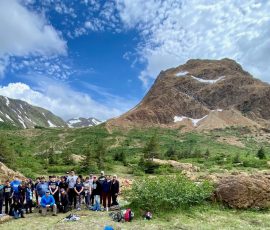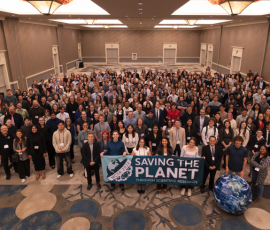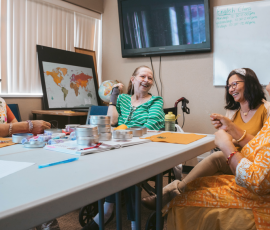In June, we were pleased to sit down with Pauline Fong, Chief Program & Impact Officer, Jill Lemke, Vice President of Grants Management & Training, and Danielle Neumann, Special Projects Support, for a conversation about Project Phoenix, the internal name for our sectoral redesign and grants application and management system updates. This was one of seven sessions for our virtual Founder’s Day celebration where we got to hear about the Trust’s work across our region, learn more about recent organizational shifts, and hear from leadership.
Because we were not able to address all audience questions live, we wanted to follow up with Pauline Fong and respond to those we missed. Read Pauline’s answers below, and scroll down for the session recording with timestamps of the conversation.
Q&As
These were questions registrants submitted before the session, or that attendees submitted during the session, that we didn’t have time to answer live. We appreciate your curiosity, and were pleased to follow up with Pauline to answer some of these questions.
What is your greatest pain point, or frustration, with the work that you are advancing?
One challenge with any grantmaking foundation is the inherent power dynamics. We are aware that although we see ourselves as partners and co-laborers with our grantees and applicants – in fact, we know that they’re the ones doing the hard work out in our communities and we are just in a position to support them – there is an inherent power imbalance in any funder/grantee relationship. Project Phoenix was, in part, addressing this imbalance, because it sought to make the grant application process more accessible to nonprofits of all sizes. It tried to make the grant application process less laborious. And it implemented direct feedback from past applicants that hopefully reduces this divide moving forward. We know that as a foundation, this dynamic will always be a reality, and we are committed to continuous improvement in this regard.
What were the benefits to the generalist model, and what benefits are you seeing to the sectoral model?
The generalist model where each program officer was managing grants across multiple sectors was great for giving program officers a breadth of experience and for identifying cross-sectoral connections. You could be working on a healthcare application, an arts organization application, and a food bank application all at once, which gave you a certain big-picture vantage point. This model served us well for nearly five decades, but as we were desiring to go deeper into our sectors and maximize our team efforts, we identified the sectoral model as a more efficient distribution of teams and knowledge. The benefit of the sectoral model where we have dedicated teams for each sector is that it enables us to focus team energy into that sector’s work, identify gaps, make connections between organizations doing similar work, and identify programs and grant opportunities that would yield maximum impact in that sector.
How did you involve all staff in this Project Phoenix process? How much was it top-level decision making and how did you recruit staff opinion/feedback as you went?
It was important to Project Phoenix leaders that we heard feedback from all levels of staff. In the early stages, in addition to externally-focused surveys and focus groups with applicants and grantees, we launched a survey of all staff in the Grants & Programs department to receive written feedback, and followed up on the survey with 30-minute meetings with each staff for further input. After we collated the feedback into themes and categories, we identified the pain points along the timeline and on various aspects of the grants process. We then took the feedback and reconfirmed that data with the staff in longer team meetings to brainstorm possible solutions.
At the outset, we also invited staff from all departments and all levels to come to us at any time with ideas, questions, or concerns. I personally set up a submission box outside of my office for written feedback in case staff felt more comfortable with that. We also reached out to individual colleagues across teams to gain a range of perspectives on what we knew would be a complex process with organization-wide impact. While decisions were ultimately made at the leadership level, we engaged in a rigorous process of listening to our internal staff and our external interest holders to inform our decisions.
Would new sectors be added to Trust funding if there was great enough demand?
The work that the Trust funds reflects the giving and stated intentions of Jack Murdock. We are always open to exploring potential partnerships with new organizations that align with Jack’s wishes for how his resources would be used. If you work for an organization that serves the common good of the Pacific Northwest but that doesn’t fit neatly into one of the Trust’s current sectors, please read the Trust Eligibility Guidelines and see if your work fits within the stated funding priorities.
While the Trust has chosen to group organizations into sectors or areas of funding, “sector” is an abstract term and many grantees have impact across multiple sectors. A nonprofit bringing outdoor education to those with learning challenges or specific healthcare concerns could fit into the Health & Environmental Stewardship sector, or the Arts, Culture, & Education sector. Many after-school programs for youth could fall into both education and community services work. The Trust’s sectors are simply meant to provide structure to our teams and guidance to applicants on the types of work we fund.
Watch the full recording and find the topics that interest you most using the timestamps below.
The Conversation
01:21: What is Project Phoenix?
03:10: How the process started
07:08: How data informed our work
09:46: Why we shifted to a sectoral strategy
12:39: Our new grants management system
18:36: Early results of this work
26:56: Is the grant processing time shorter now?
32:27: How organizational vision shaped this process
35:35: How to balance donor intent with a future mindset
39:04: Closing thoughts







